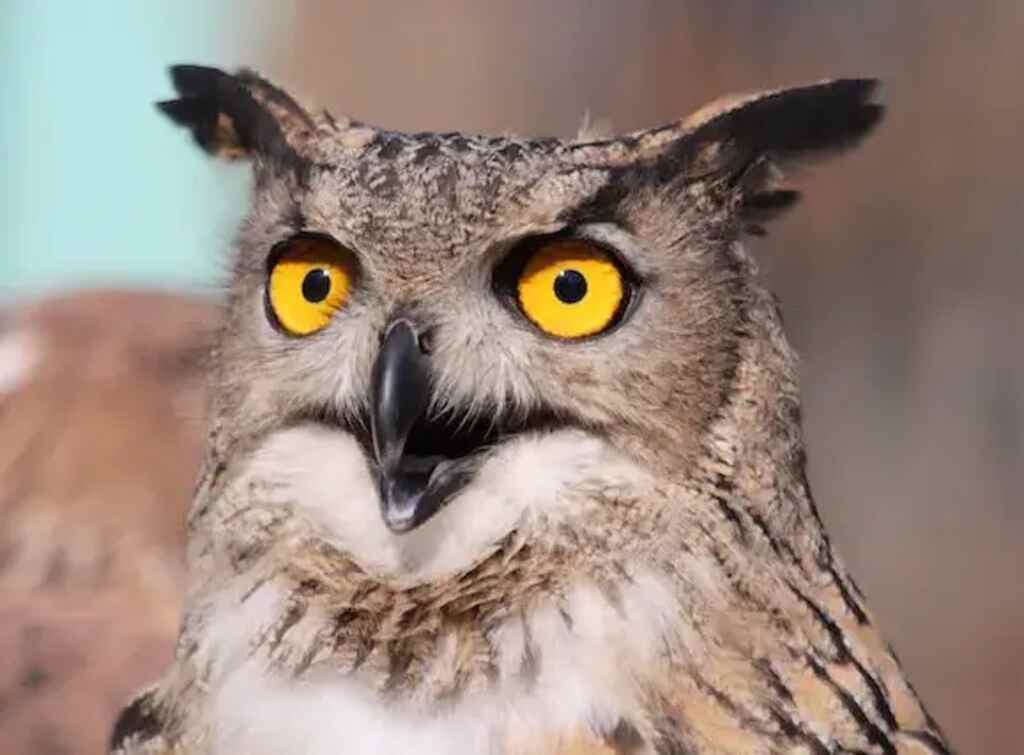What do owls sound like? Hoo, hoo, hoo goes the popular stereotype, but that’s just the tip of the iceberg. If you’re curious about the vocal talents of these nocturnal creatures, you’re in for a treat.
In this article, we’ll explore the wide range of sounds that owls make, from haunting hoots to blood-curdling screeches. Get ready to discover a whole new world of owl sounds that will leave you hooting with excitement.
Table of Contents
- 1 Definition of Owls
- 2 Importance of Owls in the Ecosystem
- 3 Overview of Owl Sounds
- 4 Types of Owl Sounds
- 5 Owl Vocalizations and Meanings
- 6 Owl Sound Adaptations
- 7 Where to Hear Owls?
- 8 Summary on What Do Owls Sound Like
- 9 Importance of Preserving Owl Habitats
- 10 The Future of Owl Sounds
- 11 FAQs For What Do Owls Sound Like?
- 12 Conclusion
- 13 Author
Definition of Owls
Owls belong to the Strigiformes order and are considered birds of prey. These creatures are widespread and can be found on every continent, with the exception of Antarctica. They inhabit a diverse range of habitats, including forests, deserts, and tundras.
There are over 200 species of owls in existence today, ranging in size from the tiny elf owl (measuring just over five inches tall) to the powerful Eurasian eagle-owl (which can have a wingspan of over six feet). One thing that sets owls apart from other birds is their specialized feathers.
Owls have feathers with fringes on their edges which help them fly silently through the air when hunting for prey at night. This feature has made owls an object of fascination for scientists who study aerodynamics.
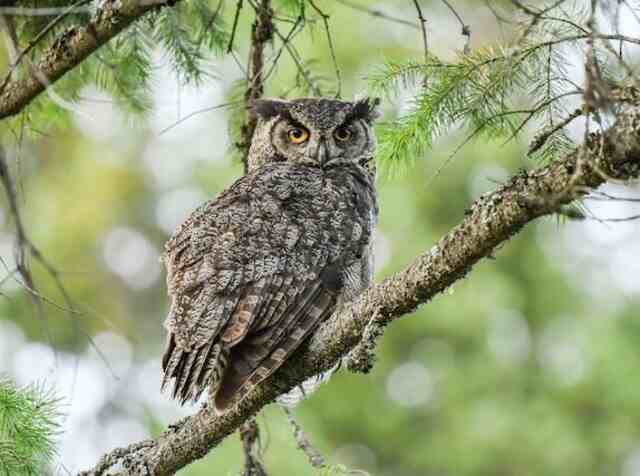
Importance of Owls in the Ecosystem
Owls play an important role in maintaining ecological balance in their respective habitats. As predators at the top of their food chain, they help regulate populations of rodents and other small mammals that might otherwise become pests or wreak havoc on local ecosystems.
In addition to controlling rodent populations, owls also serve as indicators of overall ecosystem health. Since they require healthy habitats with ample food sources to survive and thrive, declines in owl populations can signal larger environmental problems such as habitat loss or pesticide contamination.
Overview of Owl Sounds
When most people think about owl sounds, the classic “hoo-hoo” of the great horned owl likely comes to mind. However, owls have a range of vocalizations that they use for communication, including hoots, screeches, whistles, and clicks.
These sounds can vary dramatically between species and even between individuals. Owl calls can be used for a variety of purposes such as defining territory, attracting mates or offspring, warning other owls of danger or signaling aggression.
Some owl species also use non-vocal sounds such as bill clapping or wing flapping to communicate. In the following sections, we’ll explore the different types of owl sounds in more detail and discuss what they mean.

Types of Owl Sounds
Owls are known for their unique vocalizations that vary depending on the species. These sounds can range from a soft cooing to a piercing screech. Understanding the different types of owl sounds is essential to identifying specific species in the wild.
Hoots
One of the most distinguishable owl sounds is their hoot. Hoots are low, deep, and usually repeated in a pattern of 1-4 notes. The pitch and tone can vary depending on the individual bird and species.
Great Horned Owls are known for their classic “hoot-hoot” that can be heard from up to 5 miles away. Other owls that commonly hoot include Barred Owls, Barn Owls, and Eastern Screech-Owls.
Description:
Hooting is a common method for owls to communicate with each other during territorial disputes or mating season. It’s also used by parents to communicate with their young or signal danger.
Examples:
The hoot of the Great Horned Owl is often described as deep, resonant, and distinctive, consisting of five to eight hoots in a rhythmic pattern. The Barred Owl has a more complex hooting pattern that includes laughs or cackles, which sound like a human trying to impersonate a monkey. Eastern Screech-Owls have two types of hoots: one high-pitched descending whistle and one low-pitched monotone whistle.
Screeches
In contrast to hooting, screeching owl sounds are loud, high-pitched, and piercing screams that can be alarming when heard at night. Screeches are used as an alarm call or as a sign of aggression during fights over territory or food.
Description:
Screeches usually consist of one long, drawn-out note followed by a series of shorter notes. The pitch and tone can vary greatly between species.
Examples:
The Barn Owl is known for its blood-curdling screech that sounds like a woman screaming. The Barred Owl also has a distinctive screech that is lower pitched than the Barn Owl and sounds like as a series of deep hoots or a haunting melody that echoes through the night. The high-pitched trill-like screech of the Eastern Screech-Owl lasts 3–6 seconds, giving the bird its name.
Whistles
Whistling owl sounds are less common than hoots or screeches, but they are still an important part of owl communication. These sounds are gentle, melodic, and often used during social interactions between owls.
Description:
Whistles consist of one or more high-pitched notes that can sound similar to bird songs or human whistling.
Examples:
The Northern Saw-whet Owl has a soft whistle that’s reminiscent of someone blowing over the top of an empty bottle. The Elf Owl has a mellow whistle with two notes that sound like “po-totoooo” or “po-totodaaaa”. Long-eared Owls have whistles with rapid notes that sound like a bouncing ball.
| Owl Species | Sound | Reason |
|---|---|---|
| Barn Owl | Screech | Territorial defense, mating calls, food solicitations |
| Barred Owl | Hoots and screams | Territory defense, communication, mating |
| Eastern Screech Owl | Whinnies and trills | Territory defense, communication, mating |
| Great Horned Owl | Hoots, screams, and hisses | Territory defense, communication, mating, food solicitations |
| Snowy Owl | Barks and screams | Territory defense, communication, mating |
| Northern Saw-whet Owl | Series of toots and whistles | Territory defense, communication, mating, food solicitations |
| Long-eared Owl | Low hoots and barks | Territory defense, communication, mating |
| Short-eared Owl | Bark-like hoots | Territory defense, communication, mating |
Please note that the reasons for owl sounds may vary depending on the species and context.
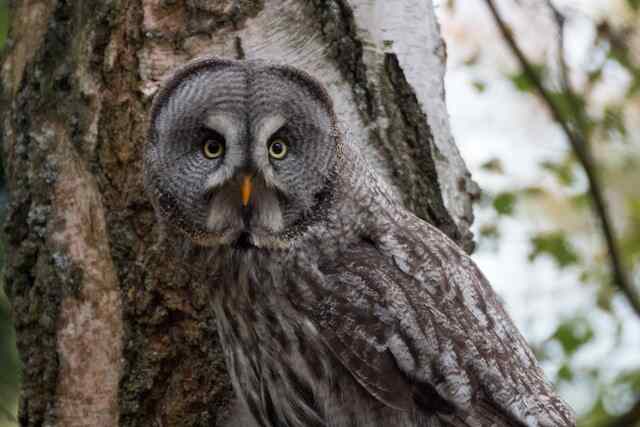
Owl Vocalizations and Meanings
Territorial Calls
Owls, like many other birds, use vocalizations to communicate with each other. One of the most common types of owl sounds is the territorial call. This call is used to defend a particular area of land from other owls or potential predators.
The territorial call varies depending on the species of owl but typically involves a series of hoots or screeches. Some owls will also use their body language, such as puffing up their feathers and spreading their wings, to further display their dominance.
For example, the great horned owl’s territorial call consists of a series of deep hoots that can be heard up to two miles away. The eastern screech-owl’s territorial call is a soft trill that sounds similar to a horse’s whinny.
| Owl Species | Sound | Purpose |
|---|---|---|
| Great Horned Owl | Deep hoots | Defend a particular area of land from other owls or potential predators |
| Eastern Screech-Owl | Soft trill | Display dominance over an area of land |
| Barred Owl | Series of hoots | Attract potential mates and identify each other during mating season |
| Barn Owl | Harsh scream | Attract potential mates and identify each other during mating season |
Mating Calls
In addition to territorial calls, owls also use vocalizations during mating season. These calls serve as a way for males and females to identify each other and attract potential mates.
Mating calls are more complex than territorial calls and vary greatly between species. They can include whistles, trills, and even hisses.
Some owl species will even dance or perform aerial displays as part of their mating rituals. For instance, the barred owl’s mating call is a series of eight hoots that sound like “Who cooks for you? Who cooks for you all?” The barn owl’s mating call is more high-pitched and resembles a harsh scream.
| Owl Species | Sound | Purpose |
|---|---|---|
| Great Gray Owl | Low-pitched hoots | Attract potential mates and identify each other during mating season |
| Snowy Owl | High-pitched barks | Attract potential mates and identify each other during mating season |
| African Scops Owl | Series of trills | Attract potential mates and identify each other during mating season |
| Southern White-faced Owl | Slow, monotonous hoo hoo | Attract potential mates and identify each other during mating season |
| Barred Owl | Series of eight hoots | Display dominance over an area of land |
| Barn Owl | Harsh scream | Display dominance over an area of land |
Examples from Different Owl Species
Each species of owl has its unique vocalization patterns and meanings attached to them. For instance, – Great Gray Owls produce sounds like low-pitched hoots.
– Snowy Owls have high-pitched barks. – African Scops Owls make a series of trills, while the Southern White-faced Owl has a slow, monotonous hoo hoo.
– The Little Owl produces a long ‘Keewik’ sound. Vocalizations are important communicative tools for owls.
Territorial and mating calls are two of the most common types of owl vocalizations that serve different purposes. Each species has its unique vocalization patterns and meanings attached to it.
| Species of Owl | Vocalization Patterns | Meaning |
|---|---|---|
| Barn Owl | Screeches, hisses, raspy calls | Hunting, territorial defense, courtship |
| Barred Owl | Eight hooting notes, “Who cooks for you? Who cooks for you-all?” | Territorial defense, courtship |
| Eastern Screech Owl | Trills, whinnies, soft hoots | Territorial defense, courtship |
| Great Horned Owl | Deep, rhythmic hoots, hisses, screeches | Territorial defense, courtship, communication |
| Northern Saw-whet Owl | Monotonous toots | Territorial defense, courtship |
| Snowy Owl | Gruff barks, clucks, hissing | Territorial defense, courtship |
| Spectacled Owl | High-pitched trills and whistles | Territorial defense, courtship |
| Western Screech Owl | Soft hoots, trills, growls, barks | Territorial defense, courtship |
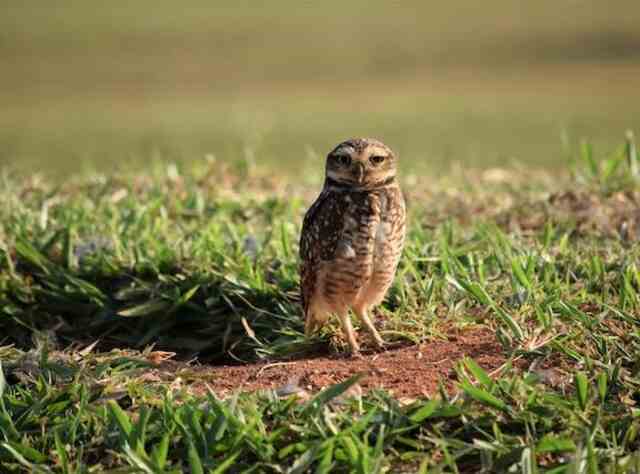
Owl Sound Adaptations
Owls have developed specific adaptations that allow them to be successful hunters and communicate with each other effectively. Three significant adaptations are their feathers’ sound-absorbing properties, ear structure for sound localization, and beak shape for sound amplification.
Owl feathers and sound absorption
Owls’ wings and bodies are covered in specialized feathers that absorb sound. These feathers have a soft, velvety texture that helps muffle the noise produced by an owl in flight. Also, they reduce the feather’s fluttering noise when flapping their wings, making it easier for owls to sneak up on prey.
The arrangement of these special feathers also helps owls fly silently by reducing turbulence near the edges of their wings. Additionally, owls have facial disc feathers that help direct sound toward their ears while hunting.
The facial disc is a circular-shaped arrangement of feathers around the owl’s face that acts as a parabolic reflector, directing sounds towards its ears. This adaptation allows owls to pinpoint the location of their prey accurately.
| Species | Feather Adaptations | Purpose |
|---|---|---|
| Barn Owl | Soft, velvety feathers | Muffles noise produced by flight |
| Specialized wing feathers | Reduces fluttering noise when flapping wings | |
| Facial disc feathers | Directs sound towards ears while hunting | |
| Great Grey Owl | Soft, fringed feathers | Muffles noise produced by flight |
| Specialized wing feathers | Reduces turbulence near edges of wings | |
| Facial disc feathers | Directs sound towards ears while hunting | |
| Spectacled Owl | Soft, fringed feathers | Muffles noise produced by flight |
| Specialized wing feathers | Reduces fluttering noise when flapping wings | |
| Facial disc feathers | Directs sound towards ears while hunting |
Owl ear structure for sound localization
Owls have unique ear structures that help them with auditory localization or identifying where sounds come from accurately. Their ears are asymmetrical; one is higher than the other on the head and covered by a flap of skin that functions similarly to an external ear canal.
These asymmetrical ears allow them to locate sounds precisely in three-dimensional space by using time differences between each side’s ear.
Furthermore, owls can increase or decrease blood flow to different parts of their ears depending on whether they want to amplify or dampen specific frequencies of sounds while hunting or communicating with other owls.
| Species | Ear Adaptations | Purpose |
|---|---|---|
| Elf Owl | Asymmetrical ears | Locates sounds precisely in three-dimensional space |
| Ear flaps | Functions similarly to external ear canal | |
| Blood flow control | Amplifies or dampens specific frequencies of sounds while hunting or communicating | |
| Long-eared Owl | Asymmetrical ears | Locates sounds precisely in three-dimensional space |
| Ear tufts | Enhances hearing ability | |
| Blood flow control | Amplifies or dampens specific frequencies of sounds while hunting or communicating | |
| Great Horned Owl | Asymmetrical ears | Locates sounds precisely in three-dimensional space |
| Ear tufts | Enhances hearing ability | |
| Blood flow control | Amplifies or dampens specific frequencies of sounds while hunting or communicating |
Owl beak shape for sound amplification
The shape of an owl’s beak also contributes significantly to its ability to communicate effectively and hunt prey. The beak’s shape and size vary depending on the species of owl, but most have a sharp, curved tip that helps them tear flesh quickly.
In some species, the beak is asymmetrical, with one nostril slightly higher than the other. This adaptation also helps owls with sound localization. The shape of an owl’s beak also affects its vocalizations; some species have a wide range of calls that vary based on their beak’s shape and size.
For example, the great horned owl’s deep hooting call is produced by air vibrating in their large throat pouches and resonating in their beaks’ hollow cavities. Owls have developed unique adaptations that help them hunt prey effectively and communicate with other owls.
Their feathers are sound absorbent, their ears are asymmetrical to locate sounds accurately, and their beaks amplify vocalizations for communication purposes.
These adaptations enable owls to live successfully in various environments worldwide while contributing significantly to maintaining ecological balance.
| Species | Beak Adaptations | Purpose |
|---|---|---|
| Snowy Owl | Sharp, curved tip | Helps tear flesh quickly |
| Asymmetrical nostrils | Helps with sound localization | |
| Vocalizations vary with beak size | Amplifies vocalizations for communication purposes | |
| Great Horned Owl | Sharp, curved tip | Helps tear flesh quickly |
| Asymmetrical nostrils | Helps with sound localization | |
| Vocalizations vary with beak size | Amplifies vocalizations for communication purposes | |
| Northern Pygmy Owl | Short, curved beak | Ideal for hunting small prey |
| Wide range of vocalizations | Produced by resonating air in throat pouches and beak cavities |
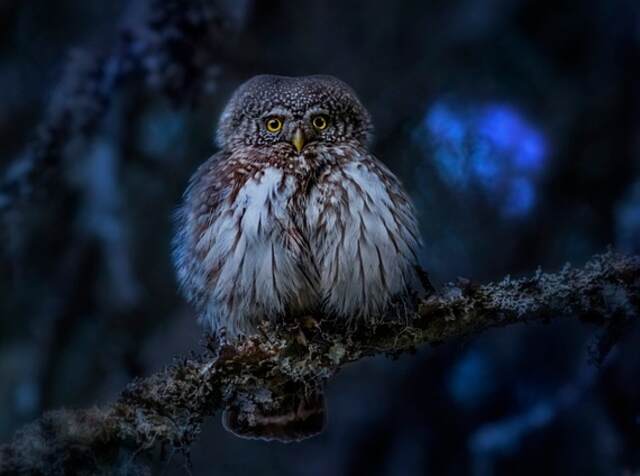
Where to Hear Owls?
Owls are nocturnal birds, making it challenging to find them during the day. However, there are ways to locate owls at night. The best way to hear owls is by visiting a natural area where they live, such as a forest or park.
Many nature preserves and wildlife refuges offer guided night walks where visitors can listen to owl calls. Another excellent place to hear owls is near bodies of water like ponds or rivers.
Owls often hunt for prey in these areas, making it an ideal location for them to call out to each other. Additionally, suburban or rural areas with large yards and trees may provide ideal habitats for some species of owls.
Best times to hear owls
The best time of year for hearing owls is during their breeding season when they are most vocal. For most owl species in North America, this occurs from late winter through the spring months.
The best time of day is typically around twilight or just after dark when they start becoming active. It’s essential not only to pay attention but also not disturb the Owls while listening not shining bright lights on them while on their territory.
Habitats Where Owls Can Be Found
Different owl species have specific habitat requirements. For example, Screech Owls require nesting sites with cavities such as old trees or nest boxes placed high above the ground; meanwhile, Great Horned Owls prefer wooded areas near open fields where they can hunt small mammals like rabbits.
Other species like Barn Owl require open grasslands for hunting rodents, while snowy owls live in arctic tundra regions and coniferous forests across North America. Therefore, any habitat that offers prey (mainly rodents) would be an attractive place for various owl species.
Safety Precautions When Listening To Owls
It is vital to take precautions when listening for owls, especially at night in remote areas. Firstly, always let someone know where you are going and when you expect to return. Secondly, bring a flashlight with extra batteries in case of an emergency.
When listening to owls, be sure not to approach them too closely, as this may disturb their natural behavior. Additionally, it’s essential not only to pay attention but also not disturb the Owls while listening not shining bright lights on them while on their territory.
It’s best not to venture off-trail or into areas with steep terrain or water bodies that may pose a danger. Overall, hearing owls in the wild can be an incredible experience as long as it’s done responsibly and safely.

Summary on What Do Owls Sound Like
Owls are nocturnal creatures that have a unique vocalization system. These birds communicate with a variety of sounds, including hoots, screeches, and whistles.
The sounds vary depending on the species and their purpose. Hoots are often associated with territorial marking and communication between members of the same species.
Screeches and whistles are usually used to signal danger or attract mates. It is fascinating to note that each owl species has a distinct sound pattern.
For instance, the great horned owl is famous for its deep hooting notes, while barn owls emit raspy screeches. Owls’ vocalizations also vary according to their age and sex, making it possible to tell them apart in the wild.
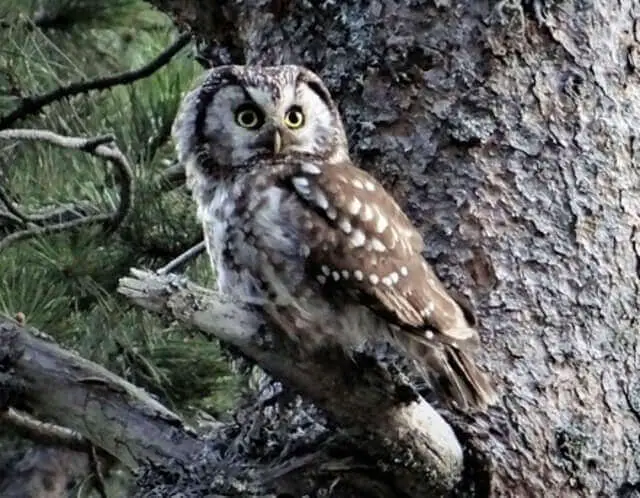
Importance of Preserving Owl Habitats
Owls play a critical role in maintaining ecological balance in various habitats worldwide. They are apex predators that feed on rodents and other small mammals that would otherwise cause harm to crops or transmit deadly diseases such as Lyme disease.
Moreover, owls’ pellets contain undigested bones and hair from their prey, which provide habitat for various insects such as beetles. However, owl populations face numerous threats due to habitat loss and degradation caused by human activities such as deforestation and urbanization.
The reduction of natural habitats limits their food sources, nesting sites, and places for roosting during the day. Additionally, pollution from pesticides can accumulate in their bodies over time, leading to health complications.
It is therefore essential to preserve owl habitats by planting trees native plants around our homes or supporting conservation organizations working towards preserving natural habitats for these magnificent birds.
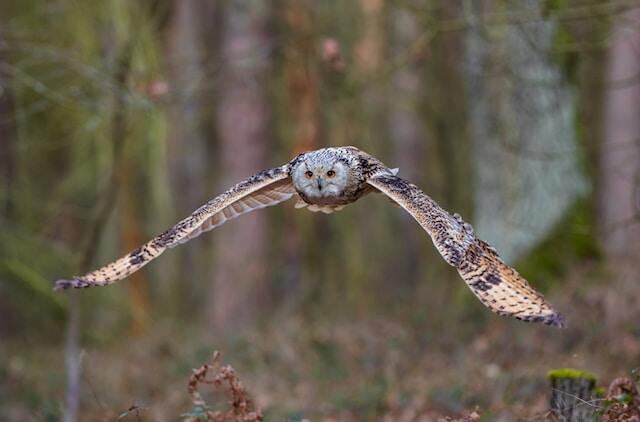
The Future of Owl Sounds
The study of owl sounds has been invaluable in understanding avian communication systems worldwide. Advancements in technology have made it possible to analyze owl sounds in detail, leading to discoveries of new vocalizations and meanings.
Future research will undoubtedly uncover more about the unique communication systems of these fascinating creatures. However, the future of owl vocalizations is uncertain as they face numerous threats from habitat loss and degradation.
It is crucial to conserve their habitats and promote sustainable living practices that support biodiversity for future generations’ benefits.
FAQs For What Do Owls Sound Like?
What noise does the owl make?
Owls make a variety of noises, including hoots, screeches, whistles, and hisses. The specific sound an owl makes depends on its species and the situation, such as mating or defending its territory.
What sounds like an owl at night?
There are several animals that can sound like an owl at night, including mourning doves, pigeons, and even tree frogs. However, the most common animal mistaken for an owl is the common loon, which has a haunting call that sounds like a hoot.
Do owls say hoo or hoot?
Although people often think of owls as saying “hoo,” they actually make a deep, throaty sound called a hoot. However, some owl species, like the Eastern Screech-Owl, can make a high-pitched “whinny” or “trill” sound that might be mistaken for a “hoo.”
Why do owls hoot at night?
Owls hoot at night for several reasons, including to defend their territory, communicate with their mate, or locate prey. Hooting is also a way for owls to establish their presence and warn other owls to stay away.
What is a typical cry of an owl?
The typical cry of an owl is a hoot, which is a deep, resonant sound that carries over long distances. However, owls can also make other sounds, such as screeches, barks, whistles, and hisses, depending on their species and the situation.
What animal makes a weird noise at night?
Many animals make weird noises at night, but one of the most unusual is the common loon. Its eerie, haunting call can sound like a hoot, and it’s often mistaken for an owl. Other animals that make strange noises at night include coyotes, foxes, and raccoons.
Do owls make noise all night?
Owls are primarily nocturnal animals, which means they are most active at night. However, they do not make noise all night long. Owls are generally quiet and still during the day, and they only hoot or make other noises when they need to communicate with other owls or defend their territory.
Conclusion
In conclusion, owls are fascinating creatures that have a wide variety of unique vocalizations. From the haunting hoots of the great horned owl to the trills of the eastern screech owl, each species has its own distinct sounds.
By learning to identify these sounds, you can gain a deeper appreciation for these nocturnal hunters and the important role they play in our ecosystem. So the next time you hear a mysterious sound in the night, take a moment to listen closely, it might just be an owl calling out to you.

